End-of-Life Care: Research Approaches and Evidence-Based Practice
VerifiedAdded on 2023/06/13
|7
|1800
|175
Report
AI Summary
This report discusses research methodologies used in the context of end-of-life care, focusing on research approaches, philosophical perspectives (ontology and epistemology), and appraisal methods. It justifies the use of a library-based approach for reviewing evidence, highlighting its importance in ensuring professional standards and avoiding research duplication. The report also details a search strategy using the PICO framework and critical appraisal using CASP tools. Furthermore, it emphasizes the significance of evidence-based practice in supporting end-of-life care decisions, integrating literature to inform clinical practice and improve patient outcomes.

Paraphrase This Document
Need a fresh take? Get an instant paraphrase of this document with our AI Paraphraser
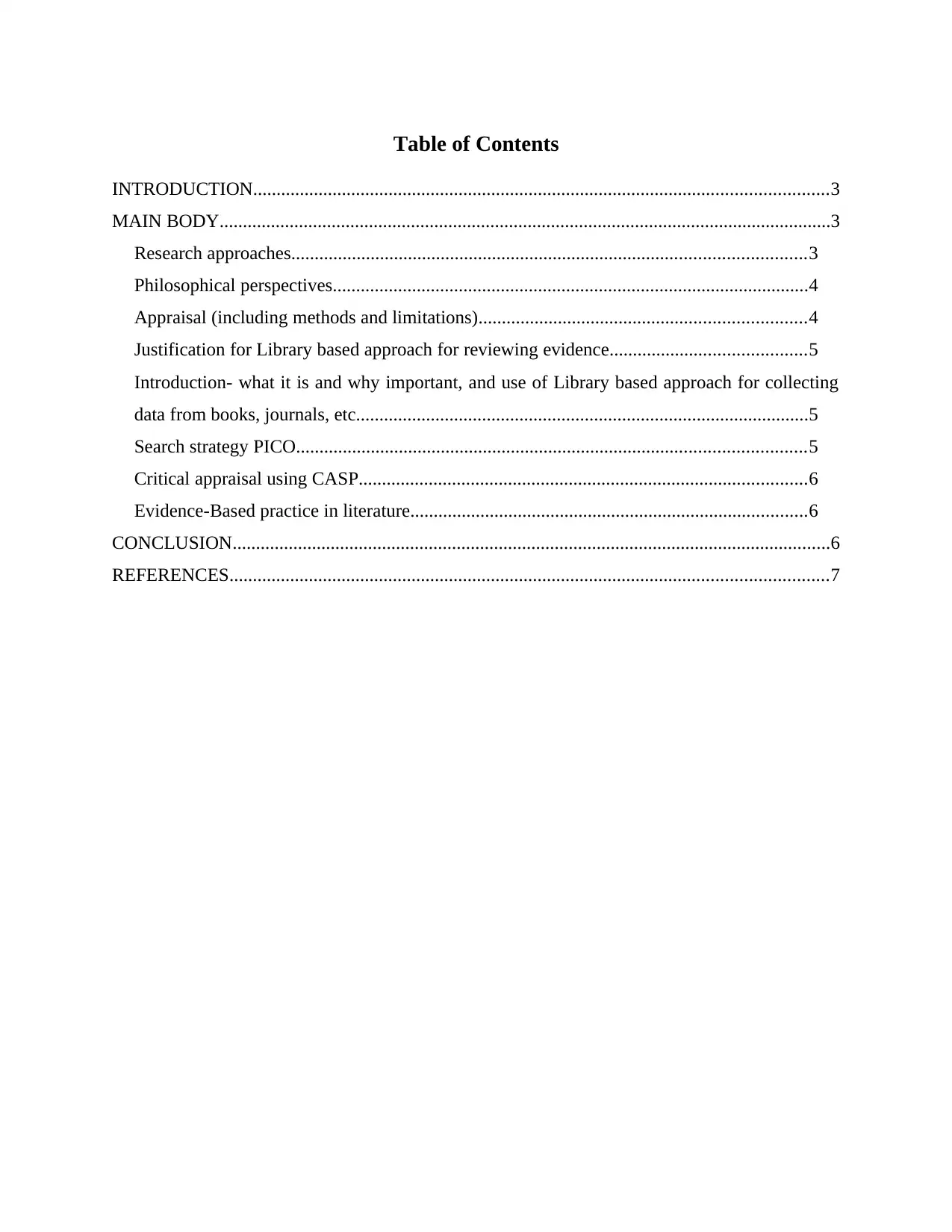
Table of Contents
INTRODUCTION...........................................................................................................................3
MAIN BODY...................................................................................................................................3
Research approaches..............................................................................................................3
Philosophical perspectives......................................................................................................4
Appraisal (including methods and limitations)......................................................................4
Justification for Library based approach for reviewing evidence..........................................5
Introduction- what it is and why important, and use of Library based approach for collecting
data from books, journals, etc.................................................................................................5
Search strategy PICO.............................................................................................................5
Critical appraisal using CASP................................................................................................6
Evidence-Based practice in literature.....................................................................................6
CONCLUSION................................................................................................................................6
REFERENCES................................................................................................................................7
INTRODUCTION...........................................................................................................................3
MAIN BODY...................................................................................................................................3
Research approaches..............................................................................................................3
Philosophical perspectives......................................................................................................4
Appraisal (including methods and limitations)......................................................................4
Justification for Library based approach for reviewing evidence..........................................5
Introduction- what it is and why important, and use of Library based approach for collecting
data from books, journals, etc.................................................................................................5
Search strategy PICO.............................................................................................................5
Critical appraisal using CASP................................................................................................6
Evidence-Based practice in literature.....................................................................................6
CONCLUSION................................................................................................................................6
REFERENCES................................................................................................................................7
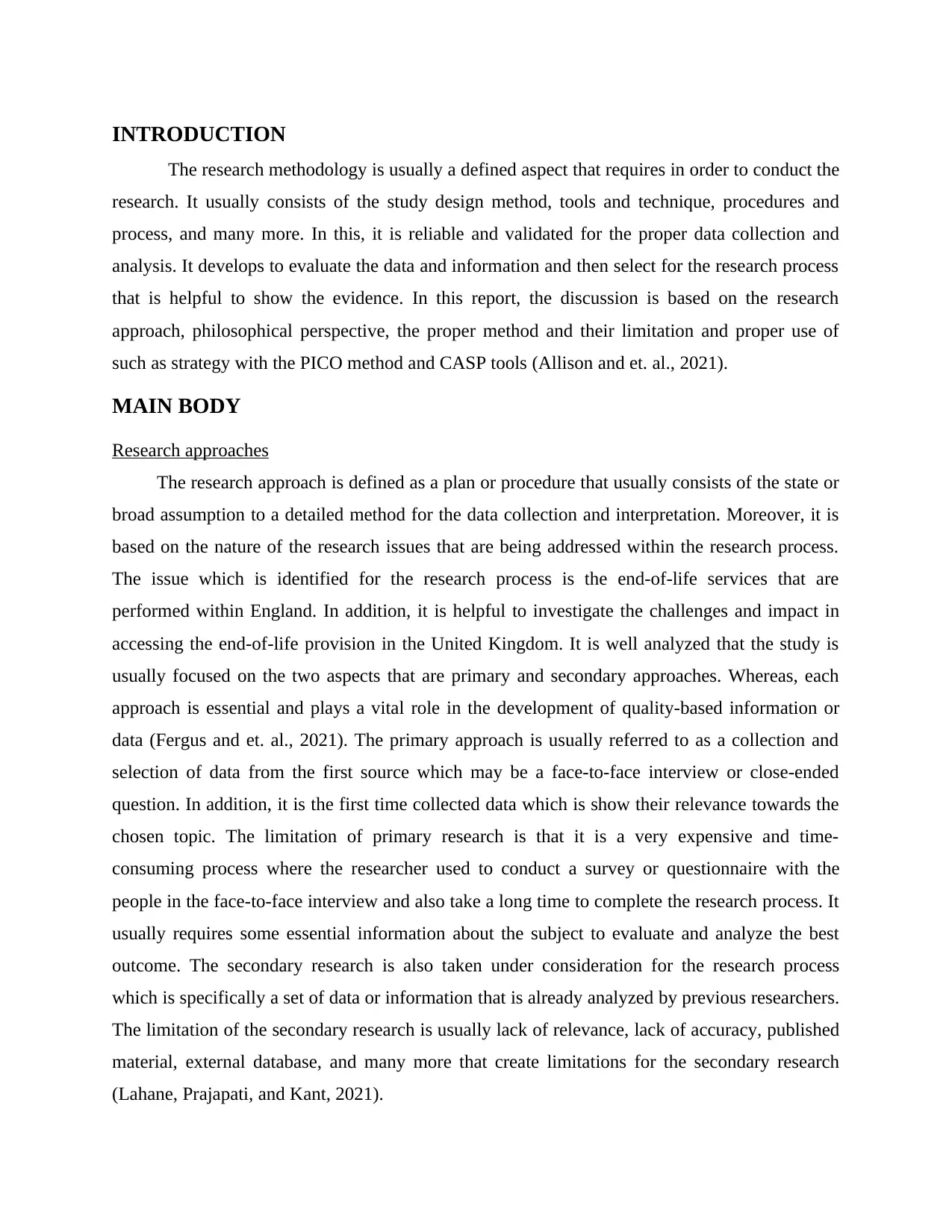
INTRODUCTION
The research methodology is usually a defined aspect that requires in order to conduct the
research. It usually consists of the study design method, tools and technique, procedures and
process, and many more. In this, it is reliable and validated for the proper data collection and
analysis. It develops to evaluate the data and information and then select for the research process
that is helpful to show the evidence. In this report, the discussion is based on the research
approach, philosophical perspective, the proper method and their limitation and proper use of
such as strategy with the PICO method and CASP tools (Allison and et. al., 2021).
MAIN BODY
Research approaches
The research approach is defined as a plan or procedure that usually consists of the state or
broad assumption to a detailed method for the data collection and interpretation. Moreover, it is
based on the nature of the research issues that are being addressed within the research process.
The issue which is identified for the research process is the end-of-life services that are
performed within England. In addition, it is helpful to investigate the challenges and impact in
accessing the end-of-life provision in the United Kingdom. It is well analyzed that the study is
usually focused on the two aspects that are primary and secondary approaches. Whereas, each
approach is essential and plays a vital role in the development of quality-based information or
data (Fergus and et. al., 2021). The primary approach is usually referred to as a collection and
selection of data from the first source which may be a face-to-face interview or close-ended
question. In addition, it is the first time collected data which is show their relevance towards the
chosen topic. The limitation of primary research is that it is a very expensive and time-
consuming process where the researcher used to conduct a survey or questionnaire with the
people in the face-to-face interview and also take a long time to complete the research process. It
usually requires some essential information about the subject to evaluate and analyze the best
outcome. The secondary research is also taken under consideration for the research process
which is specifically a set of data or information that is already analyzed by previous researchers.
The limitation of the secondary research is usually lack of relevance, lack of accuracy, published
material, external database, and many more that create limitations for the secondary research
(Lahane, Prajapati, and Kant, 2021).
The research methodology is usually a defined aspect that requires in order to conduct the
research. It usually consists of the study design method, tools and technique, procedures and
process, and many more. In this, it is reliable and validated for the proper data collection and
analysis. It develops to evaluate the data and information and then select for the research process
that is helpful to show the evidence. In this report, the discussion is based on the research
approach, philosophical perspective, the proper method and their limitation and proper use of
such as strategy with the PICO method and CASP tools (Allison and et. al., 2021).
MAIN BODY
Research approaches
The research approach is defined as a plan or procedure that usually consists of the state or
broad assumption to a detailed method for the data collection and interpretation. Moreover, it is
based on the nature of the research issues that are being addressed within the research process.
The issue which is identified for the research process is the end-of-life services that are
performed within England. In addition, it is helpful to investigate the challenges and impact in
accessing the end-of-life provision in the United Kingdom. It is well analyzed that the study is
usually focused on the two aspects that are primary and secondary approaches. Whereas, each
approach is essential and plays a vital role in the development of quality-based information or
data (Fergus and et. al., 2021). The primary approach is usually referred to as a collection and
selection of data from the first source which may be a face-to-face interview or close-ended
question. In addition, it is the first time collected data which is show their relevance towards the
chosen topic. The limitation of primary research is that it is a very expensive and time-
consuming process where the researcher used to conduct a survey or questionnaire with the
people in the face-to-face interview and also take a long time to complete the research process. It
usually requires some essential information about the subject to evaluate and analyze the best
outcome. The secondary research is also taken under consideration for the research process
which is specifically a set of data or information that is already analyzed by previous researchers.
The limitation of the secondary research is usually lack of relevance, lack of accuracy, published
material, external database, and many more that create limitations for the secondary research
(Lahane, Prajapati, and Kant, 2021).
⊘ This is a preview!⊘
Do you want full access?
Subscribe today to unlock all pages.

Trusted by 1+ million students worldwide
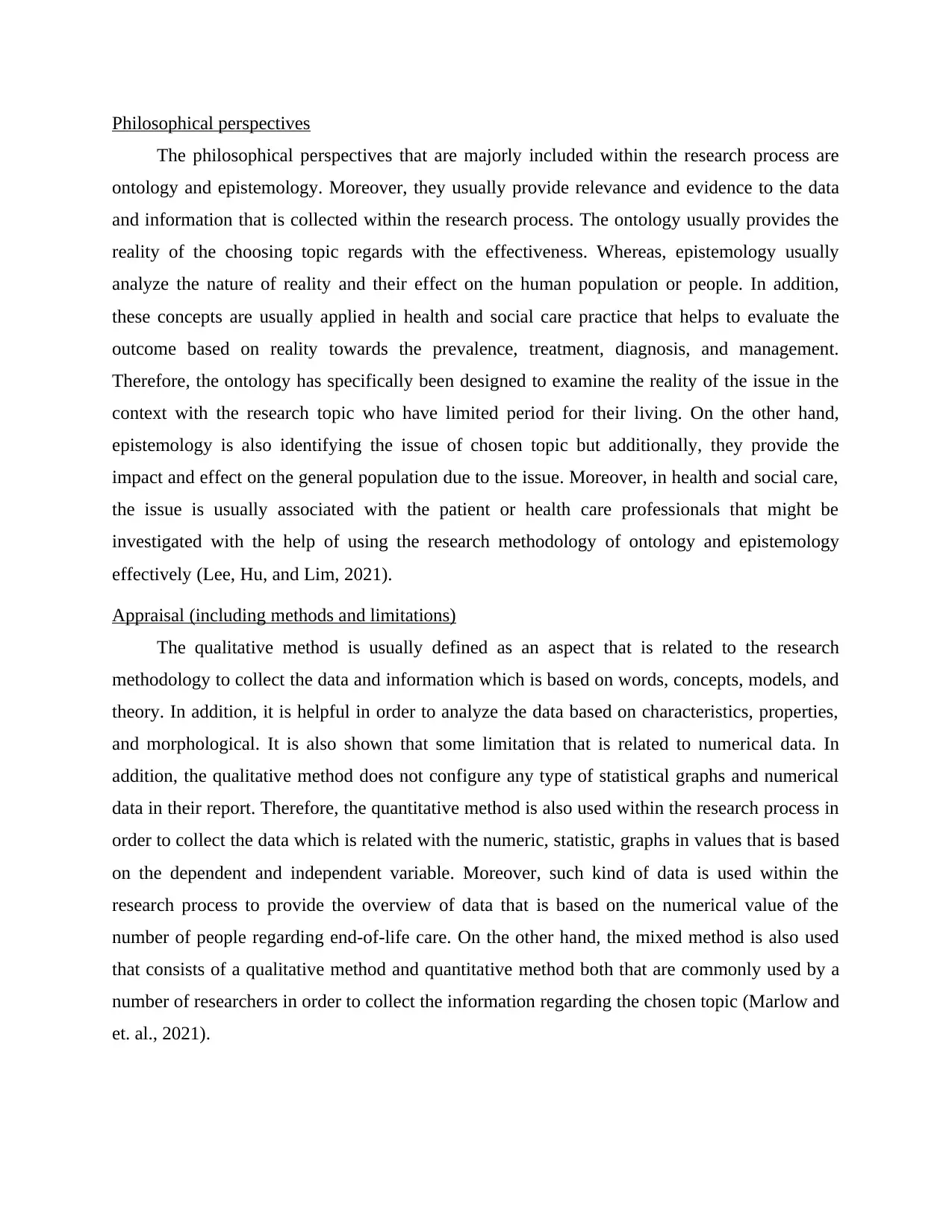
Philosophical perspectives
The philosophical perspectives that are majorly included within the research process are
ontology and epistemology. Moreover, they usually provide relevance and evidence to the data
and information that is collected within the research process. The ontology usually provides the
reality of the choosing topic regards with the effectiveness. Whereas, epistemology usually
analyze the nature of reality and their effect on the human population or people. In addition,
these concepts are usually applied in health and social care practice that helps to evaluate the
outcome based on reality towards the prevalence, treatment, diagnosis, and management.
Therefore, the ontology has specifically been designed to examine the reality of the issue in the
context with the research topic who have limited period for their living. On the other hand,
epistemology is also identifying the issue of chosen topic but additionally, they provide the
impact and effect on the general population due to the issue. Moreover, in health and social care,
the issue is usually associated with the patient or health care professionals that might be
investigated with the help of using the research methodology of ontology and epistemology
effectively (Lee, Hu, and Lim, 2021).
Appraisal (including methods and limitations)
The qualitative method is usually defined as an aspect that is related to the research
methodology to collect the data and information which is based on words, concepts, models, and
theory. In addition, it is helpful in order to analyze the data based on characteristics, properties,
and morphological. It is also shown that some limitation that is related to numerical data. In
addition, the qualitative method does not configure any type of statistical graphs and numerical
data in their report. Therefore, the quantitative method is also used within the research process in
order to collect the data which is related with the numeric, statistic, graphs in values that is based
on the dependent and independent variable. Moreover, such kind of data is used within the
research process to provide the overview of data that is based on the numerical value of the
number of people regarding end-of-life care. On the other hand, the mixed method is also used
that consists of a qualitative method and quantitative method both that are commonly used by a
number of researchers in order to collect the information regarding the chosen topic (Marlow and
et. al., 2021).
The philosophical perspectives that are majorly included within the research process are
ontology and epistemology. Moreover, they usually provide relevance and evidence to the data
and information that is collected within the research process. The ontology usually provides the
reality of the choosing topic regards with the effectiveness. Whereas, epistemology usually
analyze the nature of reality and their effect on the human population or people. In addition,
these concepts are usually applied in health and social care practice that helps to evaluate the
outcome based on reality towards the prevalence, treatment, diagnosis, and management.
Therefore, the ontology has specifically been designed to examine the reality of the issue in the
context with the research topic who have limited period for their living. On the other hand,
epistemology is also identifying the issue of chosen topic but additionally, they provide the
impact and effect on the general population due to the issue. Moreover, in health and social care,
the issue is usually associated with the patient or health care professionals that might be
investigated with the help of using the research methodology of ontology and epistemology
effectively (Lee, Hu, and Lim, 2021).
Appraisal (including methods and limitations)
The qualitative method is usually defined as an aspect that is related to the research
methodology to collect the data and information which is based on words, concepts, models, and
theory. In addition, it is helpful in order to analyze the data based on characteristics, properties,
and morphological. It is also shown that some limitation that is related to numerical data. In
addition, the qualitative method does not configure any type of statistical graphs and numerical
data in their report. Therefore, the quantitative method is also used within the research process in
order to collect the data which is related with the numeric, statistic, graphs in values that is based
on the dependent and independent variable. Moreover, such kind of data is used within the
research process to provide the overview of data that is based on the numerical value of the
number of people regarding end-of-life care. On the other hand, the mixed method is also used
that consists of a qualitative method and quantitative method both that are commonly used by a
number of researchers in order to collect the information regarding the chosen topic (Marlow and
et. al., 2021).
Paraphrase This Document
Need a fresh take? Get an instant paraphrase of this document with our AI Paraphraser
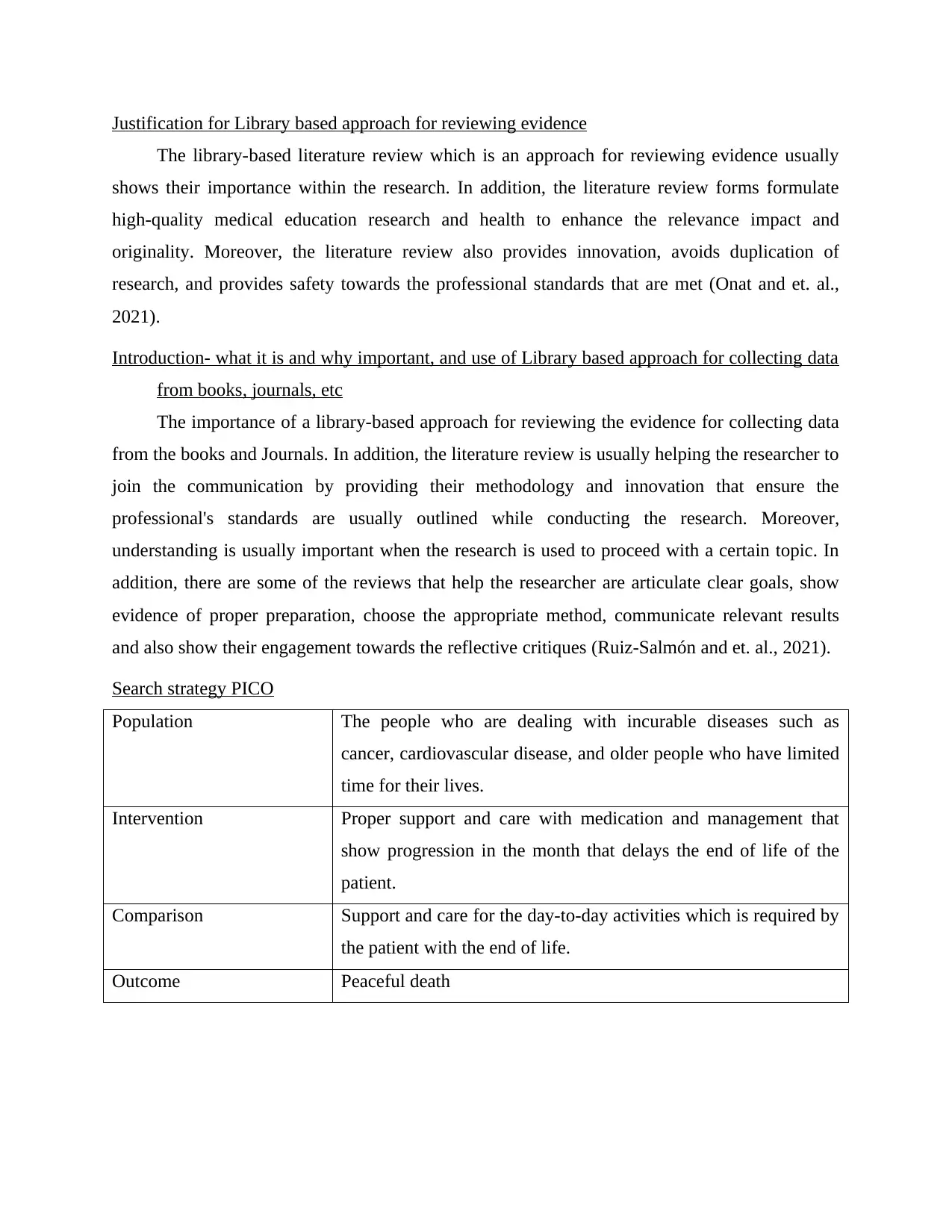
Justification for Library based approach for reviewing evidence
The library-based literature review which is an approach for reviewing evidence usually
shows their importance within the research. In addition, the literature review forms formulate
high-quality medical education research and health to enhance the relevance impact and
originality. Moreover, the literature review also provides innovation, avoids duplication of
research, and provides safety towards the professional standards that are met (Onat and et. al.,
2021).
Introduction- what it is and why important, and use of Library based approach for collecting data
from books, journals, etc
The importance of a library-based approach for reviewing the evidence for collecting data
from the books and Journals. In addition, the literature review is usually helping the researcher to
join the communication by providing their methodology and innovation that ensure the
professional's standards are usually outlined while conducting the research. Moreover,
understanding is usually important when the research is used to proceed with a certain topic. In
addition, there are some of the reviews that help the researcher are articulate clear goals, show
evidence of proper preparation, choose the appropriate method, communicate relevant results
and also show their engagement towards the reflective critiques (Ruiz-Salmón and et. al., 2021).
Search strategy PICO
Population The people who are dealing with incurable diseases such as
cancer, cardiovascular disease, and older people who have limited
time for their lives.
Intervention Proper support and care with medication and management that
show progression in the month that delays the end of life of the
patient.
Comparison Support and care for the day-to-day activities which is required by
the patient with the end of life.
Outcome Peaceful death
The library-based literature review which is an approach for reviewing evidence usually
shows their importance within the research. In addition, the literature review forms formulate
high-quality medical education research and health to enhance the relevance impact and
originality. Moreover, the literature review also provides innovation, avoids duplication of
research, and provides safety towards the professional standards that are met (Onat and et. al.,
2021).
Introduction- what it is and why important, and use of Library based approach for collecting data
from books, journals, etc
The importance of a library-based approach for reviewing the evidence for collecting data
from the books and Journals. In addition, the literature review is usually helping the researcher to
join the communication by providing their methodology and innovation that ensure the
professional's standards are usually outlined while conducting the research. Moreover,
understanding is usually important when the research is used to proceed with a certain topic. In
addition, there are some of the reviews that help the researcher are articulate clear goals, show
evidence of proper preparation, choose the appropriate method, communicate relevant results
and also show their engagement towards the reflective critiques (Ruiz-Salmón and et. al., 2021).
Search strategy PICO
Population The people who are dealing with incurable diseases such as
cancer, cardiovascular disease, and older people who have limited
time for their lives.
Intervention Proper support and care with medication and management that
show progression in the month that delays the end of life of the
patient.
Comparison Support and care for the day-to-day activities which is required by
the patient with the end of life.
Outcome Peaceful death
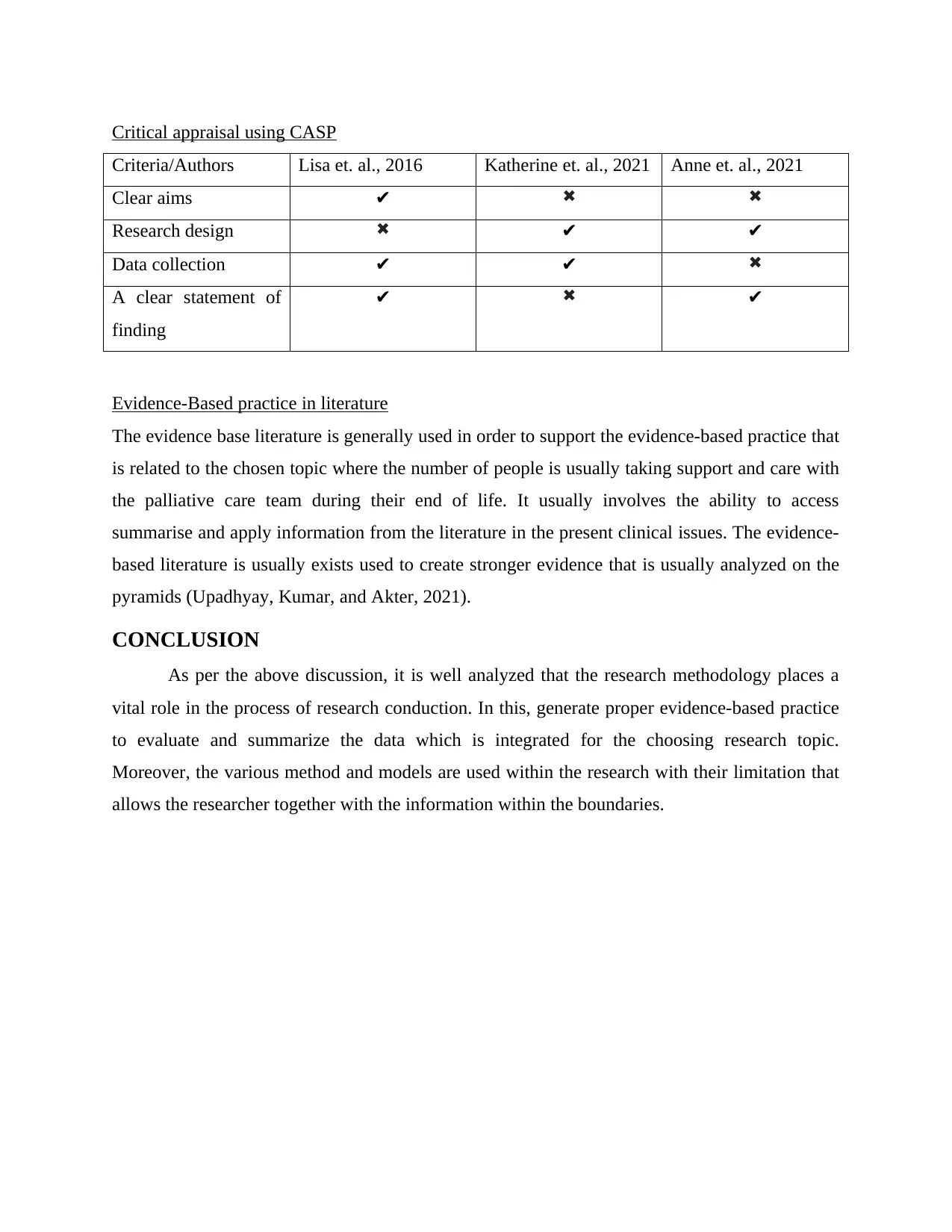
Critical appraisal using CASP
Criteria/Authors Lisa et. al., 2016 Katherine et. al., 2021 Anne et. al., 2021
Clear aims ✔ ✖ ✖
Research design ✖ ✔ ✔
Data collection ✔ ✔ ✖
A clear statement of
finding
✔ ✖ ✔
Evidence-Based practice in literature
The evidence base literature is generally used in order to support the evidence-based practice that
is related to the chosen topic where the number of people is usually taking support and care with
the palliative care team during their end of life. It usually involves the ability to access
summarise and apply information from the literature in the present clinical issues. The evidence-
based literature is usually exists used to create stronger evidence that is usually analyzed on the
pyramids (Upadhyay, Kumar, and Akter, 2021).
CONCLUSION
As per the above discussion, it is well analyzed that the research methodology places a
vital role in the process of research conduction. In this, generate proper evidence-based practice
to evaluate and summarize the data which is integrated for the choosing research topic.
Moreover, the various method and models are used within the research with their limitation that
allows the researcher together with the information within the boundaries.
Criteria/Authors Lisa et. al., 2016 Katherine et. al., 2021 Anne et. al., 2021
Clear aims ✔ ✖ ✖
Research design ✖ ✔ ✔
Data collection ✔ ✔ ✖
A clear statement of
finding
✔ ✖ ✔
Evidence-Based practice in literature
The evidence base literature is generally used in order to support the evidence-based practice that
is related to the chosen topic where the number of people is usually taking support and care with
the palliative care team during their end of life. It usually involves the ability to access
summarise and apply information from the literature in the present clinical issues. The evidence-
based literature is usually exists used to create stronger evidence that is usually analyzed on the
pyramids (Upadhyay, Kumar, and Akter, 2021).
CONCLUSION
As per the above discussion, it is well analyzed that the research methodology places a
vital role in the process of research conduction. In this, generate proper evidence-based practice
to evaluate and summarize the data which is integrated for the choosing research topic.
Moreover, the various method and models are used within the research with their limitation that
allows the researcher together with the information within the boundaries.
⊘ This is a preview!⊘
Do you want full access?
Subscribe today to unlock all pages.

Trusted by 1+ million students worldwide
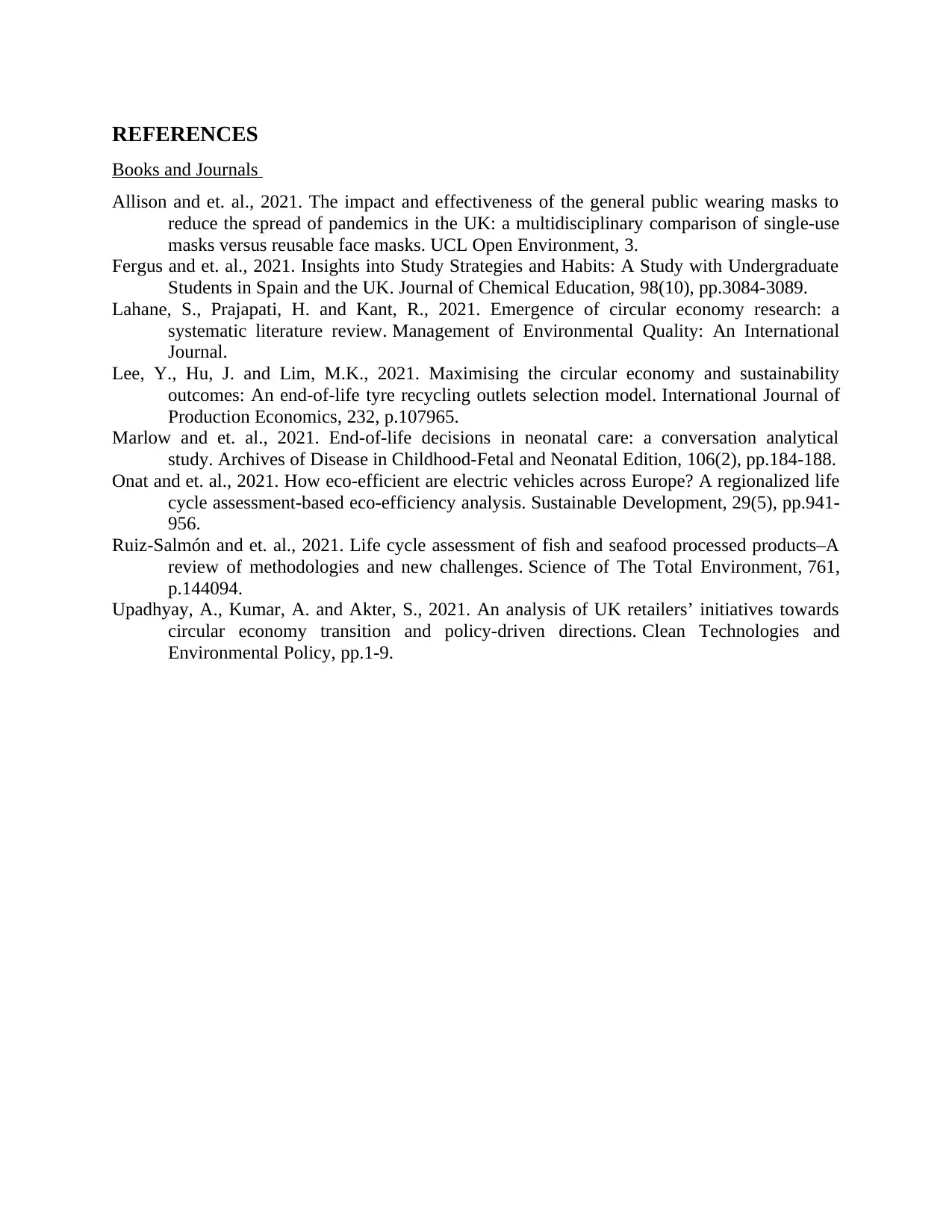
REFERENCES
Books and Journals
Allison and et. al., 2021. The impact and effectiveness of the general public wearing masks to
reduce the spread of pandemics in the UK: a multidisciplinary comparison of single-use
masks versus reusable face masks. UCL Open Environment, 3.
Fergus and et. al., 2021. Insights into Study Strategies and Habits: A Study with Undergraduate
Students in Spain and the UK. Journal of Chemical Education, 98(10), pp.3084-3089.
Lahane, S., Prajapati, H. and Kant, R., 2021. Emergence of circular economy research: a
systematic literature review. Management of Environmental Quality: An International
Journal.
Lee, Y., Hu, J. and Lim, M.K., 2021. Maximising the circular economy and sustainability
outcomes: An end-of-life tyre recycling outlets selection model. International Journal of
Production Economics, 232, p.107965.
Marlow and et. al., 2021. End-of-life decisions in neonatal care: a conversation analytical
study. Archives of Disease in Childhood-Fetal and Neonatal Edition, 106(2), pp.184-188.
Onat and et. al., 2021. How eco‐efficient are electric vehicles across Europe? A regionalized life
cycle assessment‐based eco‐efficiency analysis. Sustainable Development, 29(5), pp.941-
956.
Ruiz-Salmón and et. al., 2021. Life cycle assessment of fish and seafood processed products–A
review of methodologies and new challenges. Science of The Total Environment, 761,
p.144094.
Upadhyay, A., Kumar, A. and Akter, S., 2021. An analysis of UK retailers’ initiatives towards
circular economy transition and policy-driven directions. Clean Technologies and
Environmental Policy, pp.1-9.
Books and Journals
Allison and et. al., 2021. The impact and effectiveness of the general public wearing masks to
reduce the spread of pandemics in the UK: a multidisciplinary comparison of single-use
masks versus reusable face masks. UCL Open Environment, 3.
Fergus and et. al., 2021. Insights into Study Strategies and Habits: A Study with Undergraduate
Students in Spain and the UK. Journal of Chemical Education, 98(10), pp.3084-3089.
Lahane, S., Prajapati, H. and Kant, R., 2021. Emergence of circular economy research: a
systematic literature review. Management of Environmental Quality: An International
Journal.
Lee, Y., Hu, J. and Lim, M.K., 2021. Maximising the circular economy and sustainability
outcomes: An end-of-life tyre recycling outlets selection model. International Journal of
Production Economics, 232, p.107965.
Marlow and et. al., 2021. End-of-life decisions in neonatal care: a conversation analytical
study. Archives of Disease in Childhood-Fetal and Neonatal Edition, 106(2), pp.184-188.
Onat and et. al., 2021. How eco‐efficient are electric vehicles across Europe? A regionalized life
cycle assessment‐based eco‐efficiency analysis. Sustainable Development, 29(5), pp.941-
956.
Ruiz-Salmón and et. al., 2021. Life cycle assessment of fish and seafood processed products–A
review of methodologies and new challenges. Science of The Total Environment, 761,
p.144094.
Upadhyay, A., Kumar, A. and Akter, S., 2021. An analysis of UK retailers’ initiatives towards
circular economy transition and policy-driven directions. Clean Technologies and
Environmental Policy, pp.1-9.
1 out of 7
Related Documents
Your All-in-One AI-Powered Toolkit for Academic Success.
+13062052269
info@desklib.com
Available 24*7 on WhatsApp / Email
![[object Object]](/_next/static/media/star-bottom.7253800d.svg)
Unlock your academic potential
Copyright © 2020–2025 A2Z Services. All Rights Reserved. Developed and managed by ZUCOL.





